Youth Laborer Dies in Trench Collapse - Michigan
NIOSH In-house FACE Report 2000-03
Summary
A 17-year-old male laborer (the victim) died and a coworker was injured after one of the unprotected walls (i.e., no shoring, shielding or adequate sloping) of the trench they were working in collapsed, striking and partially burying them with soil. The day before the incident the excavator operator had removed the trench shield used during the sewer installation project to facilitate the removal of broken sewer pipes. When work was resumed the next day, the trench shield was not replaced, and the victim and a coworker (pipe setter) went into the unprotected trench to replace two sections of pipe and to check the grade of the sewer line with a grade pole. While they were placing the grade pole inside the terminal end of the sewer line, a section of the trench wall caved in, striking and burying the victim to his mid-chest and his coworker to his knees. The foreman, who had been working above the trench at ground level, called 911 at 9:39 a.m. and requested emergency medical services (EMS). EMS, law enforcement, and the fire department personnel arrived within 5 minutes of the 911 call. The Fire Marshall assumed responsibility for rescue operations and site safety and, in his role as Incident Commander (IC), assigned Operations Officer duties to one of the fire fighters. The Operations Officer, realizing that the trench walls remained unstable and hazardous, directed coworkers, who had jumped into the trench to render assistance, to leave the trench until fire fighters could obtain the necessary protective systems to ensure safe rescue operations. Coworkers refused to leave the trench and continued digging to free the trapped workers. The Operations Officer asked law enforcement personnel to remove the foreman from the incident site when he demanded that EMS and fire fighters go into the unprotected trench. The foreman was removed from the incident site. While fire fighters were waiting for the arrival of protective systems, they set ground pads (sheets of plywood) along the side opposite the collapse to provide paramedics with a more stable point from which to lower an oxygen tank and oxygen administration equipment. Coworkers placed an oxygen mask on the victim. By this time he had become ashen in color and was semi-conscious, with a weak pulse and labored respirations. Both the victim and his injured coworker were freed by their coworkers, placed on backboards, and carried to the shallow east end of the trench. With assistance from fire fighters working above at ground level, coworkers lifted the victim and his injured coworker to fire fighters. They in turn carried the injured workers to an area where paramedics were standing by. Both workers were treated by paramedics and transported by ambulance to a local hospital where the injured coworker was admitted in serious condition and subsequently released. The victim underwent emergency surgery, experienced a cardiac arrest, and died at 2:03 p.m., approximately 5 hours following the incident.
NIOSH investigators concluded that, to help prevent similar occurrences, employers should:
- ensure that workers are protected at all times from potential cave-ins by an adequate protective system
- know and comply with child labor laws which include prohibitions against work by youths less than 18 years of age in occupations which have been declared by the Secretary of Labor to be particularly hazardous (Hazardous Orders)
- ensure that whenever Professional Employer Organizations (PEOs) serve as co-employers, they highlight the age of minors and note the need for compliance with child labor laws
- identify all workers on the work site who are under 18 years old and make their presence known to all other employees on the work site Inform all employees of the work assignments that are appropriate for these youthful workers and the limits on what they can do
- ensure that a competent person conducts daily inspections of excavations, adjacent areas and protective systems and takes appropriate measures necessary to protect workers
- provide workers with training in the recognition and avoidance of unsafe conditions and the required safe work practices that apply to their work environments
Additionally, NIOSH recommends
- all persons on an incident site should follow the directions of qualified rescue personnel who have assumed responsibility for rescue operations and site safety.
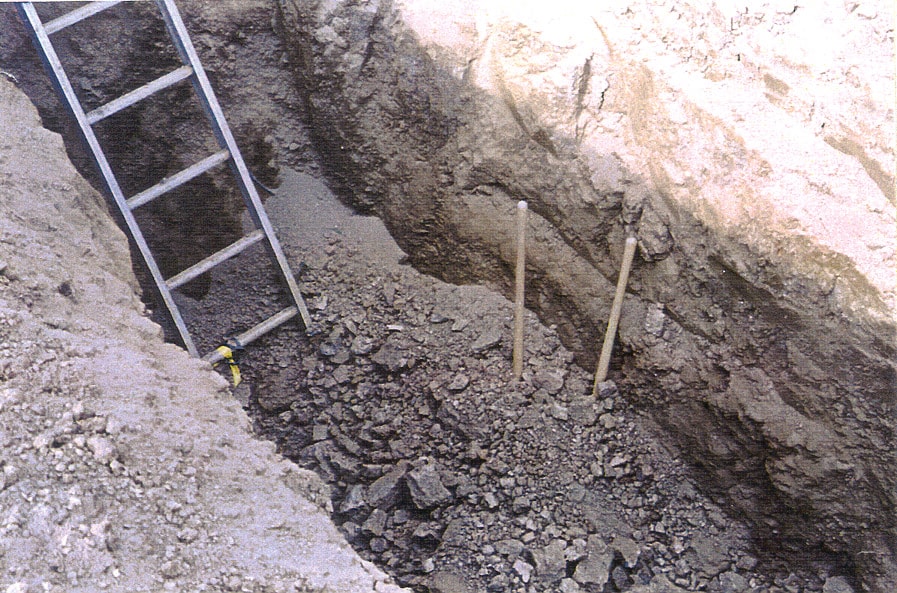
|
|
Incident Scene
|
Introduction
On November 10, 1999, a 17-year-old male laborer (the victim) died and a coworker was injured after one of the unprotected walls (i.e., no shoring, shielding or adequate sloping) of the trench they were working in collapsed, striking and partially burying them with soil. On November 15, 1999, officials of the Wage and Hour Division of the Department of Labor notified the Division of Safety Research (DSR) of this fatality. On November 22, 1999, a DSR occupational safety and health specialist conducted an investigation of the incident. The incident was reviewed with personnel from the U.S. Department of Labor Wage and Hour Division, Michigan Department of Labor, and the medical examiner’s office. Neither the victim’s work site employer nor his administrative employer, a Professional Employer Organization (PEO), were available for interview. The construction site where the incident occurred was visited and photographs obtained during the investigation.
In this incident, the victim’s work site employer was a construction contractor and his administrative employer was a PEO. The process by which the co-employers hired the victim was as follows. The construction contractor hired the victim. The PEO then reviewed his application, performed the data entry, and then put the victim on the PEO’s payroll.
The construction contractor had approximately 31 years of experience in construction-related activities. He had owned his business for approximately 28 years. In 1996, the contractor entered into a contract with a PEO, making the PEO the administrative employer for the company’s employees. At the time of the incident the contractor had 25 full-time employees, including the victim, working under this co-employer arrangement. According to the Michigan Department of Labor, the construction contractor had a safety program but had not implemented the program or provided the victim with safety training. The company had the victim sign a document acknowledging his receipt of the Michigan Occupational Safety and Health Administration (MIOSHA) Standard Handbook which outlines the requirements for protective support systems in excavations. The company’s foreman held weekly tool box talks with the crew which included trench safety but the victim had not yet taken part in these talks. The incident occurred on the victim’s second week of employment and his third day working at the incident site. Thiswas the first fatality in the history of the construction company.
The victim’s co-employer was a PEO which provided administrative services to the construction company and its employees. Administrative services included a full-featured employee benefit and human resource program. The PEO had been in business for 70 years and employed approximately 38 administrative staff. According to the PEO’s brochure, the PEO becomes a co-employer with the Client (another business entity) and provides a full-featured employee benefit and human resource management program. The brochure says in part that “we handle the employee paperwork and the administration. As the work site employer, you direct your staff’s day-to-day activities, just like you always have. The difference is, we spend our time on things that always seem to take up your time.” The brochure also indicates that the Client has the PEO’s help with work site safety procedures, analysis of the work site, identification of potential problems, preparation of an employee safety manual, and assistance in utilizing these tools at the client’s work site The Client Service Agreement initiated by the PEO and agreed upon by Client says that the Client agrees to comply at its expense with all safety, health, and work laws, regulations, directives and rules. Investigators were unable to determine whether there had been any services other than benefits services provided by the PEO to the victim or the construction contractor. This was the first fatality in the PEO’s history.
Back to Top
Investigation
The construction contractor was hired by a private industrial park development enterprise to install a sewer system on a 3.5-acre site. According to official reports, work had been ongoing at the site for several weeks, and approximately 200 feet of sewer line had been laid (see Figure 1). The sewer installation crew working at the site on the day of the incident consisted of five men including the victim. Also present at the site was a self-employed excavator operator who had been hired as a subcontractor by the construction contractor. His job was to dig the trench, lower sewer system components, move the trench box, and to refill the trench after the sewer system was in place. He was operating a 162-horsepower, diesel-powered, track-mounted hydraulic excavator which was manufactured after 1995.
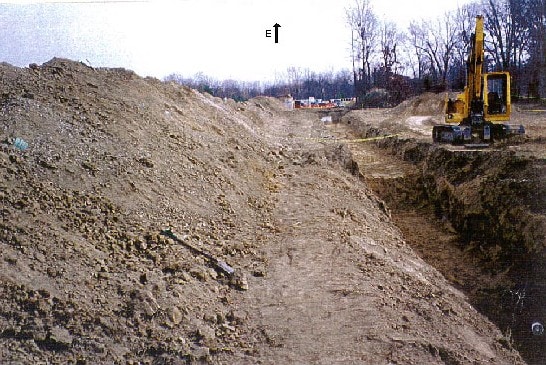
|
|
Figure 1. Sewer Installation Project (Trench pictured
is approximately 200 feet long.) |
On the day before the incident, the excavator operator struck two sections of pipe with the bucket of the hydraulic excavator and broke them as he compacted and leveled sand over a completed section of sewer line. When he tried to lift and remove the broken pipes, they broke off beyond the location of the trench shield. Because the excavator operator could not get the pipes out of the trench with the trench shield in place, he removed the trench shield, which had been used throughout the sewer line installation, and placed it approximately 20 yards to the south of the trench (see Figure 2). The excavator operator and the sewer line installation crew then quit work for the day.
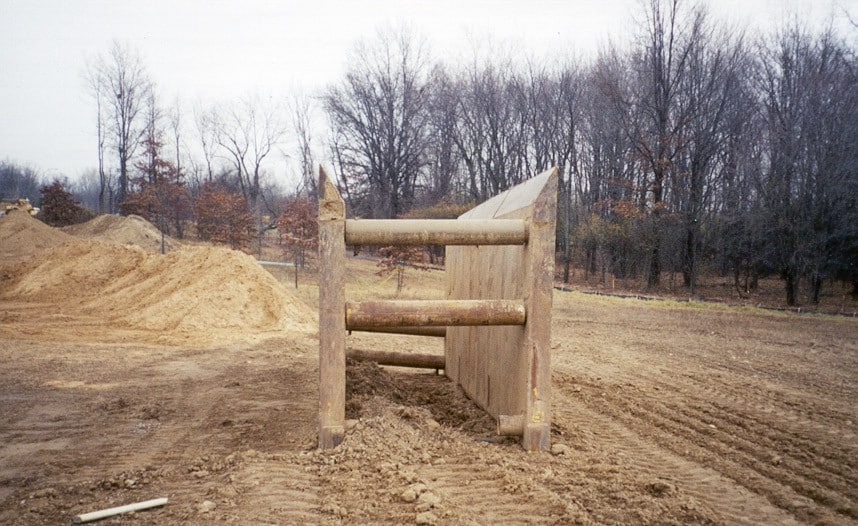
|
|
Figure 2. Shield (Shield was removed from the trench
with an excavator and placed 20 yards from the trench.)
|
When work resumed at approximately 7:30 a.m. the next morning, the excavator operator removed the broken pipe. He did not replace the trench shield before he lowered new sections of pipe into the trench. He then waited nearby with the hydraulic excavator running since his next task, after the line was repaired and properly aligned, would have been to lower a cement manhole into place. The victim and a coworker (pipe setter) went into the unprotected trench to set the two new sections of pipe. The trench was approximately 11 feet deep and 8 feet wide in the area in which they were working. After they had set the pipe, a coworker, working above them at ground level, handed thema grade pole. While they were placing the grade pole inside the end of the pipe to allow them to check the grade of the sewer line, a section of the unprotected trench wall 30 feet long by 11 feet high and several feet thick caved in (see Figure 3). A portion of this fallen section struck the victim and his coworker, burying the victim up to his mid-chest and his coworker up to his knees (see Figure 4).
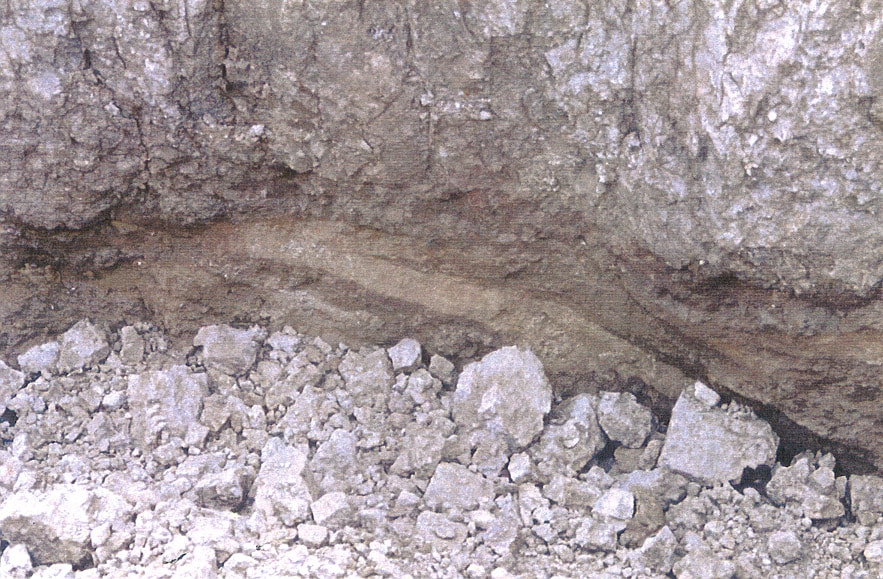
|
|
Figure 3. Cave-In Area (Looking South, cave-in area
is approximately 30 feet long and 11 to 13 feet deep.)
|
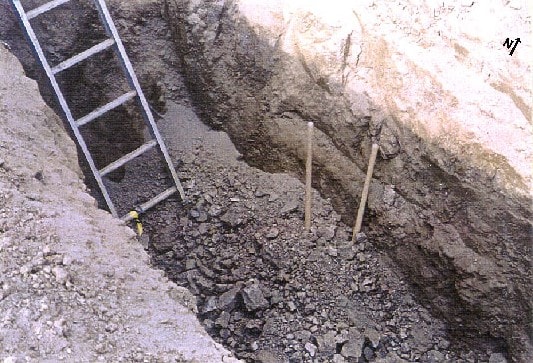
|
|
Figure 4. Incident Scene (The victim and his co-worker
were buried near the west end of the trench.)
|
The foreman called 911 at 9:39 a.m. and requested emergency medical services (EMS). In the meantime, two coworkers and the excavator operator jumped into the trench, and using shovels and their bare hands, tried to free the partially buried workers. EMS, law enforcement, and fire department personnel arrived within 5 minutes of the 911 call. The Fire Marshall assumed responsibility for rescue operations and for site safety and, in his role as Incident Commander (IC), assigned Operations Officer duties to one of the fire fighters. The Operations Officer, realizing that the trench walls remained unstable and hazardous, directed the victim’s coworkers to leave the trench until protective systems could be installed, but the coworkers refused. The Operations Officer directed the victim’s foreman to shut down all machinery while fire fighters made arrangements to obtain and install protective systems before effecting a rescue. The Operations Officer asked law enforcement officers to remove the foreman from the incident site when he demanded that fire fighters and EMS enter the trench without the benefit of protective systems. A police officer removed the foreman from the immediate area. While waiting for another fire department unit to deliver protective systems, fire fighters obtained plywood from a nearby business and placed it on the spoil side (north) of the trench opposite the area where the trench wall had collapsed. Using the plywood ground pads for support, paramedics lowered an oxygen cylinder and a non-rebreather mask to the victim’s coworkers who placed the mask on the victim. At this time, the victim was ashen gray in color and semi-conscious, with a weak pulse and labored respirations. The injured coworker was conscious, verbalizing his pain, and had normal skin color.
Within 22 minutes and before protective systems had been placed in the trench by fire fighters, coworkers freed both workers and, after securing them on backboards, carried them to the east end of the trench. In the meantime, fire fighters placed a ladder into the east end of the trench where the trench depth was approximately 3 to 4 feet deep. Coworkers slid the backboards, on which the victims had been secured, up the ladder to fire fighters who reached down from above to receive them. The injured workers were treated by paramedics and transported via ambulance to a local hospital. The injured coworker was admitted in serious condition and subsequently recovered. The victim underwent emergency surgery, experienced a cardiac arrest, and died at 2:03 p.m., approximately 5 hours following the incident.
Back to Top
Cause of Death
The Medical Examiner listed the cause of death as abdominal trauma.
Recommendations and Discussion
Recommendation #1: Employers should ensure that workers are protected at all times from potential cave-ins by an adequate protective system.1, 2
Discussion: 29 CFR 1926.652 (a) (1) states that “each employee in an excavation shall be protected from cave-ins by an adequate protective system.” MIOSHA R408.40941 (1) requires a similar level of protection. In this incident, reports indicate that an adequate protective system, a heavy-duty trench shield, had been placed in the trench during the pipe-laying process. It had been removed in order to remove pipes that had been broken during soil compacting. When work conditions change and necessitate the temporary removal of the protective system in use, employers must ensure that all workers are removed from the trench. Only when an appropriate protective system is again placed in the trench should workers be allowed to reenter the trench.
Recommendation #2: Employers should know and comply with child labor laws which include prohibitions against work by youths less than 18 years of age in occupations which have been declared by the Secretary of Labor to be particularly hazardous (Hazardous Orders).3
Discussion: The Fair Labor Standards Act provides a minimum age of 18 years for work which the Secretary of Labor declares to be particularly hazardous (Hazardous Orders). One of the 17 Hazardous Orders prohibits minors from some types of work in excavation operations. (Hazardous Order No.17). With regard to trench work, this order prohibits the employment of persons less than 18 years of age from excavating, working in, or backfilling trenches that are 4 feet deep or greater at any point. Employers who employ workers less than 18 years of age should contact the U.S. Department of Labor Wage and Hour Division and the agency in their State that regulates child labor to obtain information regarding appropriate work assignments for young workers.
Recommendation #3: Whenever Professional Employer Organizations (PEOs) serve as co-employers, they should highlight the age of minors and note the need for compliance with child labor laws.
Discussion: The need for clarification regarding the appropriate work assignments for youths is particularly critical when the young worker has two employers as was the case in this incident. The contract written between the PEO, the administrative employer, and the work site employer, in this instance the construction contractor, should accurately communicate and highlight the age of all employees who are under 18 years old. The contract should accurately identify the occupations and industries to which youths can be assigned and there should be a clear agreement between the parties that work assignments are to be made in compliance with Child Labor Laws. If this level of detail cannot be accomplished in the general contract currently used, a special contract should be developed that addresses these issues. In this incident, there was nothing on the victim’s application or in the general contract that highlighted the age of the employee or made reference to activities that would be prohibited for youthful workers.
Recommendation #4: Employers should identify any worker on their work site who is under 18 years old and make their presence known to all other employees on the work site They should inform all employees of the work assignments that are appropriate for these youthful workers and the limits on what they can do.
Discussion: Supervision, work activities, and employees present at construction sites can change rapidly. Employers should inform all of their workers when workers under 18 years old will be working on site and inform them of the work activities that are permitted for these youthful workers. Whenever questions or safety concerns arise, they should contact the employer for advice and clarification. In this incident, it is not known if the person assigning work tasks and/or coworkers realized that the worker was a minor.
Recommendation #5: Employers should ensure that a competent person * conducts daily inspections of excavations, adjacent areas and protective systems and takes appropriate measures necessary to protect workers.
Discussion: 29 CFR 1926.651 (k) (1) requires that “daily inspections of excavations, the adjacent areas, and protective systems shall be made by a competent person for evidence of a situation that could result in possible cave-ins, indications of failure of protective systems, hazardous atmospheres, or other hazardous conditions. An inspection shall be conducted by the competent person prior to the start of work and as needed throughout the shift.” 29 CFR 1926.651 (k) (2) requires that “where the competent person finds evidence of a situation that could result in a possible cave-in, indications of failure of protective systems, hazardous atmospheres or other hazardous conditions, exposed employees shall be removed from the hazardous area until the necessary precautions have been taken to ensure their safety.” MIOSHA Construction Safety Standards (MIOSHA R408.40932(5) require an ongoing inspection of an excavation or trench by a qualified person. Police records indicate that the foreman at the incident site informed police that he was the supervisor for the pipeline installation work crew. The foreman/supervisor typically is the person given competent-person responsibilities. If an inspection by a competent person had been carried out in compliance with OSHA regulations, unsafe conditions may have been recognized and the workers may have been removed from the trench until necessary safety precautions had been taken.
Recommendation #6: Employers should provide workers with training in the recognition and avoidance of unsafe conditions and the required safe work practices that apply to their work environments.1, 2
Discussion: According to 29 CFR 1926.21 (b)(2), “the employer shall instruct each employee in the recognition and avoidance of unsafe conditions and the regulations applicable to his work environment to control or eliminate any hazards or other exposure to injury or illness.” MIOSHA R408.40114 (2)(d) requires that the employer have an accident prevention program that provides instruction to each employee in the recognition and avoidance of hazards. Training in recognizing and avoiding hazards should be given to all workers, coupled with employer assessments that workers are competent in the recognition of hazards and safe work practices. Youths less than 18 years of age should receive training on prohibited work tasks and settings (activities deemed to be especially dangerous for youths by the employer and/or child labor regulations), as well as hazards and safe work practices that apply to work they are permitted to perform.
Additional note/recommendation: All persons on an incident site should follow the directions of qualified rescue personnel who have assumed responsibility for rescue operations and site safety.
Discussion: The Fire Marshall assumed responsibility for rescue operations and site safety and, in his role as Incident Commander (IC), assigned Operations Officer duties to one of the fire fighters on the incident site. When the Operations Officer told coworkers to leave the unprotected trench, they refused, placing themselves at risk for becoming victims themselves. All persons at the incident site should follow the directions given by the Incident Commander or his/her designee in order to provide the most optimal circumstances for the safety of all persons on the site during rescue operations.
* Competent person is defined by OSHA as one who is capable of identifying existing and predictable hazards in the surroundings or working conditions which are unsanitary, hazardous, or dangerous to employees and who has the authorization to take prompt corrective measures to eliminate them.
References
- CFR 1926 (1998). Code of Federal Regulations, Washington D.C.: U.S. Government Printing Office, Office of the Federal Register.
- Michigan Occupational Safety and Health Act, (Act 154 of 1974, as Amended), Department of Consumer and Industry Services, 1991. Department of Consumer and Industry Services, Construction Safety Standards Parts 1 and 9.
- DOL (1990b). Child labor requirements in nonagricultural occupations under the Fair Labor Standards Act. Washington D.C.: U.S. Department of Labor, Employment Standards Administration, Wage and Hour Division WH 1330.
Investigator Information
This investigation was conducted by Doloris N. Higgins, Occupational Safety and Health Specialist, Fatality Assessment and Control Evaluation Team, Surveillance and Field Investigations Branch, Division of Safety Research.
In-house Reports
